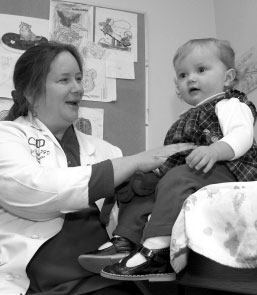Seeking treatment consensus for babies with HLHS
The 1990s were a busy decade for Pamela Jenkins: After finishing up her M.D. at the University of North Carolina and a residency in pediatrics at Dartmouth- Hitchcock Medical Center, she completed a Ph.D. in 1999 at Dartmouth's Center for the Evaluative Clinical Sciences (CECS). While she was at it, she had two children and is expecting her third in May.
Malformation: Crowning these accomplishments, Jenkins was recently awarded two grants— one from the Doris Duke Foundation and the other from the federal Agency for Healthcare Research and Quality—to support her investigation of outcomes for children born with a congenital malformation of the heart called hypoplastic left heart syndrome (HLHS).
The condition, in which the left ventricle of the heart fails to develop properly, can be successfully treated in some babies— about half of the children born with HLHS now have good long-term outcomes. This is a dramatic change; 15 years ago, according to Jenkins, there was virtually no treatment for the condition and it was considered invariably fatal.
Twofold problem: The problem Jenkins is working on is twofold: Which babies will do well? And which treatment works best? Because the condition is rare, affecting fewer than 1,000 newborns a year in the United States, information on it is scarce. Some hospitals, Jenkins has found, do not even collect data on HLHS outcomes.
Also in part because of the condition's rarity, there is no consensus about the likely outcomes of surgical intervention or even about when it is advisable to operate. Treatment choice for HLHS, Jenkins explains, "is highly practitionerdependent. Some offer only comfort to these babies, some offer all the options.
"We know that a high degree of babies who survive have neurological impairment," she adds, but the source of the impairment is not clear. There is controversy about whether such damage is usually preexisting or is a result of surgery. "It looks like the majority already had impairments before the surgery," Jenkins explains, "perhaps because of reduced blood flow in utero. There might be multisystem problems prior to birth."
Anomalies: One approach to this uncertainty is to do diagnostic tests before surgery, using MRI and EEG to identify babies who already have anomalies in order to untangle which outcomes are the result of surgery and which existed before the intervention. Such information may help to clarify which babies are most likely to benefit from intervention, as well as which intervention has the most promising outcomes in terms of both reducing neurological and other side effects and increasing long-term survival.
If there is little consensus about what to do for babies with HLHS, there is even less about where to do it. Some hospitals do not treat these babies at all; at other hospitals, staged surgery is used to repair the defects in the heart. A third option is heart transplant, but it is not common because donor hearts for neonates are scarce.
There is, in addition, controversy about whether such babies should be treated only by surgeons who specialize in the treatment of HLHS. "There are a lot of different numbers coming from a lot of different places," Jenkins says, which has contributed to "a phenomenal amount of heat" within the profession about which babies to treat and how to treat them.

|
|
In her clinical work, pediatrician Pam Jenkins sees a lot of basically healthy
children like this one, but her research focuses on outcomes for babies born
with a congenital malformation of the heart that used to be invariably fatal. |
She feels that her position as a pediatrician who is neither a cardiologist nor a surgeon is probably the best platform to work from, since she is not a stakeholder in the debate.
In fact, Jenkins observes, it is pediatricians, not cardiologists or cardiac surgeons, who have shown the most interest in her work to date. She thinks this is because "pediatricians have to deal with these babies now, because they're living—15 years ago they weren't. Survival rates and functional outcomes are important. Although pediatricians are usually not the ones who advise parents when the babies are born, they do have to care for these children long-term."
Long-term outcomes: "It is essentially 15 years since treatment for this condition started," Jenkins explains. "We don't know of any surviving 15-year-olds, but we do know of 10-year-olds." Studying long-term outcomes in these children will help identify prognosticators for good outcomes and make clearer which surgical approaches are superior, Jenkins predicts.
The model for her research is that of her mentor, Gerald O'Connor, Ph.D., associate director of the CECS; a decade ago, he helped to organize a collaborative research effort looking at outcomes of heart surgery in adults. "His approach is what I've hoped to achieve," Jenkins explains, "on a much smaller scale, because the number of patients with HLHS is so much smaller. But Gerry started with the same approach, taking one disease category and then branching out."
Scarce information: What Jenkins hopes to do is to show "some kinds of gains or results of the research for this one disorder, and then work on creating an improvement group that can move into other areas."
Both O'Connor's mentorship and Jenkins's own work at the CECS have convinced her of the value of this kind of research— collecting scarce information on thorny problems.
"The utility of one-on-one patient encounters, in these very rare and difficult situations, is limited," she observes, because singular incidents don't add up to a useful knowledge base. "The value of this research is that it can extend our knowledge," she says, and, in the long run, improve outcomes for babies.
-Megan McAndrew Cooper
If you would like to offer any feedback about this article, we would welcome getting your comments at DartMed@Dartmouth.edu.
